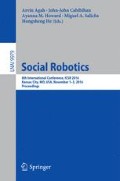Abstract
Humans are typically skilled interaction partners and detect even small problems during an interaction. In contrast, interactive robot systems often lack the basic capabilities to sense the engagement of their interaction partners and keep a common ground. This becomes even more problematic if humanoid robots with human-like behavior are used as they build up high expectations in terms of their cognitive capabilities. This paper contributes an approach for analyzing human engagement during object references in an explanation scenario based on time series alignment. An experimental guide scenario in a smart home environment was used to collect a training and test dataset where the engagement classification is carried out by human operators. The experiments already performed on the dataset give deeper insights into the presented task and motivate an incremental, mixed modality approach to engagement classification. While some of the results rely on external sensors they give an outlook on the requirements and possibilities for HRI scenarios with next-gen social robots.
Access this chapter
Tax calculation will be finalised at checkout
Purchases are for personal use only
Notes
- 1.
VFOA is short for visual focus of attention.
References
Yu, C., Aoki, P.M., Woodruff, A.: Detecting user engagement in everyday conversations. Science, p. 4 (2004)
Bohus, D., Horvitz, E.: Learning to predict engagement with a spoken dialog system in open-world settings. In: SIGdial 2009, London, UK (2009)
Yamazaki, K., Yamazaki, A., Okada, M., Kuno, Y., Kobayashi, Y., Hoshi, Y., Pitsch, K., Luff, P., Lehn, D., Heath, C.: Revealing gauguin: engaging visitors in robot guide s explanation in an art museum. In: CHI 2009 Proceedings of the SIGCHI Conference on Human Factors in Computing Systems, pp. 1437–1446 (2009)
Jang, M., Ahn, B.K., Park, C., Yang, H.S., Kim, J.H., Cho, Y.J., Lee, D.W., Cho, H.K., Kim, Y.A., Chae, K.: Building an automated engagement recognizer based on video analysis. In: Proceedings of the 2014 ACM/IEEE International Conference on Human-Robot Interaction - HRI 2014, pp. 182–183. ACM Press, New York (2014)
Michalowski, M.P., Simmons, R.: Multimodal person tracking and attention classification. In: Proceeding of the 1st ACM SIGCHI/SIGART Conference on Human-Robot Interaction - HRI 2006, p. 349 (2006)
Rich, C., Ponsler, B., Holroyd, A., Sidner, C.: Recognizing engagement in human-robot interaction. In: 2010 5th ACM/IEEE International Conference on Human-Robot Interaction (HRI) (2010)
Holthaus, P., Leichsenring, C., Bernotat, J., Richter, V., Pohling, M., Carlmeyer, B., Köster, N., Meyer zu Borgsen, S., Zorn, R., Schiffhauer, B., Engelmann, K.F., Lier, F., Schulz, S., Cimiano, P., Eyssel, F.A., Hermann, T., Kummert, F., Schlangen, D., Wachsmuth, S., Wagner, P., Wrede, B., Wrede, S.: How to Address Smart Homes with a Social Robot? A Multi-modal Corpus of User Interactions with an Intelligent Environment, European Language Resources Association (ELRA) (2016)
Ba, S., Odobez, J.M.: Recognizing visual focus of attention from head pose in natural meetings. IEEE Trans. Syst. Man Cybern. Part B (Cybern.) 39(1), 16–33 (2009)
Pitsch, K., Wrede, S.: When a robot orients visitors to an exhibit. Referential practices and interactional dynamics in real world HRI. In: The 23rd IEEE International Symposium on Robot and Human Interactive Communication, pp. 36–42. IEEE (2014)
Wienke, J., Wrede, S.: A middleware for collaborative research in experimental robotics. In: International Symposium on System Integration, Kyoto, Japan (2011)
Acknowledgments
The authors acknowledge the financial support from the Cluster of Excellence Cognitive Interaction Technology CITEC (EXC 277), Bielefeld University and the Volkswagen Foundation (Dilthey Fellowship Interaction & Space, K. Pitsch).
Author information
Authors and Affiliations
Corresponding author
Editor information
Editors and Affiliations
Rights and permissions
Copyright information
© 2016 Springer International Publishing AG
About this paper
Cite this paper
Dankert, T., Goerlich, M., Wrede, S., Gehle, R., Pitsch, K. (2016). Engagement Detection During Deictic References in Human-Robot Interaction. In: Agah, A., Cabibihan, JJ., Howard, A., Salichs, M., He, H. (eds) Social Robotics. ICSR 2016. Lecture Notes in Computer Science(), vol 9979. Springer, Cham. https://doi.org/10.1007/978-3-319-47437-3_91
Download citation
DOI: https://doi.org/10.1007/978-3-319-47437-3_91
Published:
Publisher Name: Springer, Cham
Print ISBN: 978-3-319-47436-6
Online ISBN: 978-3-319-47437-3
eBook Packages: Computer ScienceComputer Science (R0)

